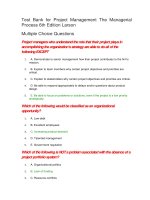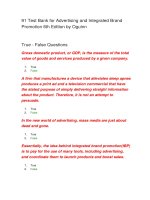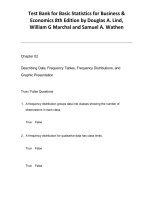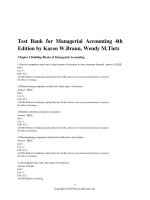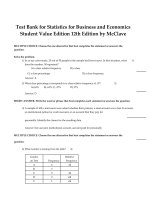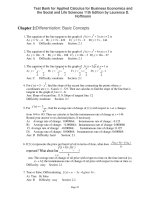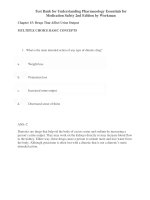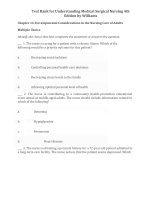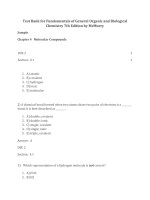Link full download test bank for pharmacology and the nursing process 6th edition by lilley
Bạn đang xem bản rút gọn của tài liệu. Xem và tải ngay bản đầy đủ của tài liệu tại đây (273.95 KB, 7 trang )
Test Bank for Pharmacology and the Nursing Process 6th Edition
by Lilley
Test Bank
Chapter 03: Life Span Considerations
MULTIPLE CHOICE
1.
Drug transfer to the fetus is more likely during the last trimester of pregnancy for
which reason?
A. Decreased fetal surface area
B. Increased placental surface area
C. Enhanced placental blood flow
D. Increased amount of protein-bound drug in maternal circulation
ANS: C
Drug transfer to the fetus is more likely during the last trimester as a result of enhanced
placental blood flow. The other options are not correct. Increased fetal surface area, not
decreased, is a factor that affects drug transfer to the fetus. The placenta’s surface area
does not increase during this time. Drug transfer is increased because of an increased
amount of free drug, not protein-bound drug, in the mother’s circulation.
DIF: COGNITIVE LEVEL: Understanding (Comprehension)
TOP: NURSING PROCESS: General
MSC: NCLEX: Health Promotion and Maintenance
2.
REF: Page 37
The nurse is monitoring a 22-year-old patient who is in the 26th week of pregnancy
and has developed gestational diabetes and pneumonia. She is given medications that
pose a possible fetal risk, but the potential benefits may warrant the use of the
medications in her situation. The nurse recognizes that these medications are in which
U.S. Food and Drug Administration (FDA) pregnancy safety category?
A. Category B
B. Category C
C. Category D
D. Category X
ANS: C
Pregnancy category D fits the description given. Category B indicates no risk to animal
fetus; information for humans is not available. Category C indicates adverse effects
reported in animal fetus; information for humans is not available. Category X consists
Mosby items and derived items © 2011, 2007, 2004 by Mosby, Inc., an affiliate of Elsevier Inc.
of drugs that should not be used in pregnant women because of reports of fetal
abnormalities and positive evidence of fetal risk in humans.
3.
DIF: COGNITIVE LEVEL: Applying (Application)
REF: Page 37
TOP: NURSING PROCESS: Assessment
MSC: NCLEX: Safe and Effective Care Environment: Safety and Infection Control
When discussing dosage calculation for pediatric patients with a clinical pharmacist,
the nurse notes that which type of dosage calculation is used most commonly in
pediatric calculations? A. West nomogram
B. Clark rule
C. Height-to-weight ratio
D. Mg/kg formula
ANS: D
The mg/kg formula is the most common method of calculating doses for pediatric
patients. The other options are available methods but are not the most commonly used.
Height-to-weight ratio is not used.
DIF: COGNITIVE LEVEL: Remembering (Knowledge)
TOP: NURSING PROCESS: Implementation
MSC: NCLEX: Health Promotion and Maintenance
4.
REF: Page 39
The nurse is assessing a newly admitted 83-year-old patient and determines that the
patient is experiencing polypharmacy. Which statement most accurately illustrates
polypharmacy?
A. The patient has lower risk for drug interactions.
B. The patient takes one medication for an illness several times a day.
C. The patient risks problems only if over-the-counter medications are also taken.
D. The patient takes multiple medications for several different illnesses.
ANS: D
Polypharmacy usually occurs when a patient has several illnesses and takes medications
for each of them, possibly prescribed by different specialists who may be unaware of
other treatments the patient is undergoing. The other options are not correct.
Polypharmacy would cause a higher risk for drug interactions. Polypharmacy means the
patient is taking several different medications, not just one. Polypharmacy can include
prescription drugs, over-the-counter medications, and herbal products.
DIF: COGNITIVE LEVEL: Understanding (Comprehension)
REF: Page 41
TOP: NURSING PROCESS: Assessment
MSC: NCLEX: Physiological Integrity: Pharmacological Therapies
Mosby items and derived items © 2011, 2007, 2004 by Mosby, Inc., an affiliate of Elsevier Inc.
5.
The nurse is aware that confusion, forgetfulness, and increased risk for falls are
common responses of an elderly patient who is taking which type of drug?
A. Laxatives
B. Anticoagulants
C. Sedatives
D. Diuretics
ANS: C
Sedatives and hypnotics often cause confusion, daytime sedation, ataxia, lethargy,
forgetfulness, and increased risk for falls in the elderly. Laxatives, anticoagulants, and
diuretics may cause adverse effects in the elderly, but not the ones specified in the
question.
DIF: COGNITIVE LEVEL: Remembering (Knowledge)
TOP: NURSING PROCESS: Implementation
MSC: NCLEX: Health Promotion and Maintenance
6.
REF: Page 43
For accurate medication administration to pediatric patients, the nurse must take into
account which criteria? A. Weight and organ maturity
B. Renal output and weight
C. Weight, body temperature, and age
D. Height and age
ANS: A
To administer medications to pediatric patients accurately, one must take into account
the body surface area (including weight and height), age, and organ maturity. The other
options are not correct; renal output and body temperature are not considerations, and
height and age alone are not sufficient.
DIF: COGNITIVE LEVEL: Understanding (Comprehension)
TOP: NURSING PROCESS: Implementation
MSC: NCLEX: Health Promotion and Maintenance
7.
REF: Page 38
It is not uncommon for an elderly patient to experience a reduction in the stomach’s
ability to produce hydrochloric acid. This change may result in which effect?
A. Delayed gastric emptying
B. An increase in gastric acidity
C. Decreased intestinal absorption of medications
D. Altered absorption of weakly acidic drugs such as aspirin
Mosby items and derived items © 2011, 2007, 2004 by Mosby, Inc., an affiliate of Elsevier Inc.
ANS: D
Reduction in the stomach’s ability to produce hydrochloric acid is an aging-related
change that results in a decrease in gastric acidity and may alter the absorption of
weakly acidic drugs, such as aspirin. The other options are not results of reduced
hydrochloric acid production.
DIF: COGNITIVE LEVEL: Applying (Application)
TOP: NURSING PROCESS: Assessment
MSC: NCLEX: Health Promotion and Maintenance
8.
REF: Page 42
The nurse is administering drugs to neonates and should consider which factor that
may contribute to drug toxicity?
A. The lungs are immature.
B. The kidneys are small.
C. The liver is not fully developed.
D. Excretion of the drug occurs quickly.
ANS: C
A neonate’s liver is not fully developed and cannot detoxify many drugs. The other
options are not correct. The lungs and kidneys do not play major roles in drug
metabolism. Renal excretion of the drug is slow, not fast, because of organ immaturity.
DIF: COGNITIVE LEVEL: Understanding (Comprehension)
TOP: NURSING PROCESS: Planning
MSC: NCLEX: Health Promotion and Maintenance
9.
REF: Page 38
An 83-year-old woman has been given a thiazide diuretic to treat mild heart failure.
She and her daughter should be told to watch for which problems?
A. Constipation and anorexia
B. Fatigue and dehydration
C. Daytime sedation and lethargy
D. Edema, nausea, and blurred vision
ANS: B
Electrolyte imbalance, fatigue, and dehydration are common complications when
thiazide diuretics are given to elderly patients. The other options do not describe
complications that occur when these drugs are given to the elderly.
Mosby items and derived items © 2011, 2007, 2004 by Mosby, Inc., an affiliate of Elsevier Inc.
DIF: COGNITIVE LEVEL: Understanding (Comprehension)
REF: Page 43
TOP: NURSING PROCESS: Planning
MSC: NCLEX: Physiological Integrity: Pharmacological Therapies
10. An elderly patient with a new diagnosis of hypertension will be receiving a new
prescription for an antihypertensive drug. The nurse expects which type of dosing to
occur with this drug therapy?
A. Drug therapy will be based on the patient’s weight.
B. Drug therapy will be based on the patient’s age.
C. The patient will receive the maximum dose that is expected to reduce the blood
pressure.
D. The patient will receive the lowest possible dose at first, and then the dose will be
adjusted as needed.
ANS: D
As a general rule, dosing for the elderly should follow the admonition, “Start low and
go slow,” which means to start with the lowest possible dose (often less than an average
adult dose) and increase the dose slowly, based on patient response.
DIF: COGNITIVE LEVEL: Understanding (Comprehension)
REF: Page 41
TOP: NURSING PROCESS: Planning
MSC: NCLEX: Physiological Integrity: Pharmacological Therapies
11. The nurse is trying to give a liquid medication to a
-year-old child and notes that
the medication has a strong taste. Which technique is the best way for the nurse to give
the medication to this child?
A. Give the medication with spoonfuls of sherbet.
B. Add the medication to the child’s bottle.
C. Tell the child you have candy for him.
D. Add the medication to a cup of milk.
ANS: A
Sherbet or another nonessential food disguises the taste of the medication. The other
options are not correct. If the child does not drink the entire contents of the bottle,
medication is wasted and the full dose is not administered. Using the word candy with
drugs may lead to the child thinking that drugs are actually candy. If medication is
mixed with a cup of milk, the child may not drink the entire cup of milk, and the
distasteful drug may cause the child to refuse milk in the future.
DIF:
COGNITIVE LEVEL: Applying (Application)
REF: Page 46
Mosby items and derived items © 2011, 2007, 2004 by Mosby, Inc., an affiliate of Elsevier Inc.
TOP: NURSING PROCESS: Implementation
MSC: NCLEX: Physiological Integrity: Pharmacological Therapies
MULTIPLE RESPONSE
1. Which statements are true regarding pediatric patients and pharmacokinetics? Select all
that apply.
A. The levels of microsomal enzymes are decreased.
B. Perfusion to the kidneys may be decreased and may result in reduced renal function
C. First-pass elimination is increased because of higher portal circulation.
D. First-pass elimination is reduced because of the immaturity of the liver.
E. Total body water content is much less than in adults.
F. Gastric emptying is slowed because of slow or irregular peristalsis.
G. Gastric emptying is more rapid because of increased peristaltic activity.
ANS: A, B, D, F
In children, first-pass elimination by the liver is reduced because of the immaturity of
the liver, and microsomal enzymes are decreased. In addition, gastric emptying is
reduced because of slow or irregular peristalsis. Perfusion to the kidneys may be
decreased, resulting in reduced renal function. The other options are not correct. In
addition, remember that total body water content is greater in children than in adults.
DIF: COGNITIVE LEVEL: Applying (Application)
TOP: NURSING PROCESS: Assessment
MSC: NCLEX: Health Promotion and Maintenance
REF: Page 38
2. Which statements are true regarding the elderly and pharmacokinetics? Select all that
apply.
A. The levels of microsomal enzymes are decreased.
B. Fat content is increased because of decreased lean body mass.
C. Fat content is decreased because of increased lean body mass.
D. The number of intact nephrons is increased.
E. The number of intact nephrons is decreased.
F. Gastric pH is less acidic.
G. Gastric pH is more acidic.
ANS: A, B, E, F
In the elderly, levels of microsomal enzymes are decreased because the aging liver is
less able to produce them; fat content is increased because of decreased lean body mass;
the number of intact nephrons is decreased as the result of aging; and gastric pH is less
Mosby items and derived items © 2011, 2007, 2004 by Mosby, Inc., an affiliate of Elsevier Inc.
acidic because of a gradual reduction of the production of hydrochloric acid. The other
options are incorrect statements.
DIF: COGNITIVE LEVEL: Applying (Application)
TOP: NURSING PROCESS: Assessment
MSC: NCLEX: Health Promotion and Maintenance
REF: Page 42
OTHER
1. A newborn infant needs a dose of acetaminophen. The order reads, “Give
acetaminophen, infant oral solution, 10 mg/kg/dose, every 4 hours as needed.” The
infant weighs 7.8 pounds. How many milligrams will this infant receive per dose?
Round to the nearest tenth.
ANS:
35 mg
Convert pounds to kilograms: 7.8 pounds = 3.5 kg (rounded to the nearest tenth)
3.5 kg 10 mg/kg/dose = 35 mg/dose
DIF: COGNITIVE LEVEL: Applying (Application)
REF: Page 39
TOP: NURSING PROCESS: Implementation
MSC: NCLEX: Physiological Integrity: Pharmacological and Parenteral Therapies
Mosby items and derived items © 2011, 2007, 2004 by Mosby, Inc., an affiliate of Elsevier Inc.
